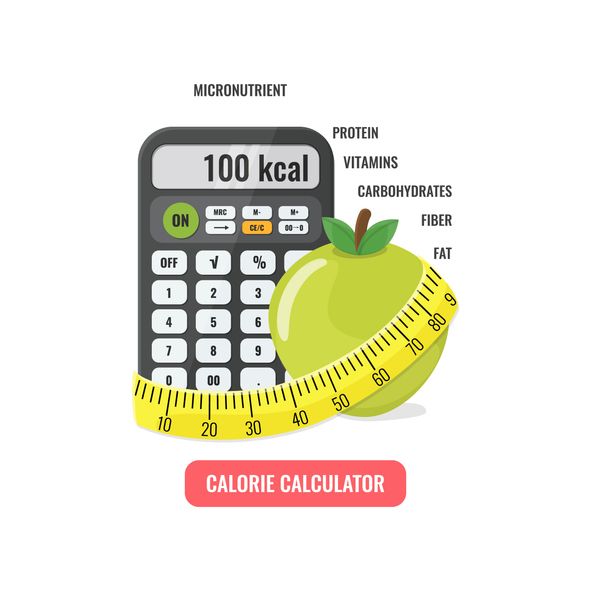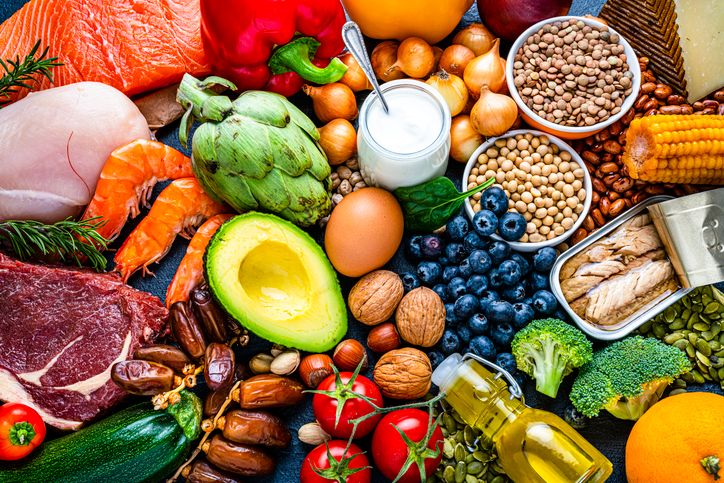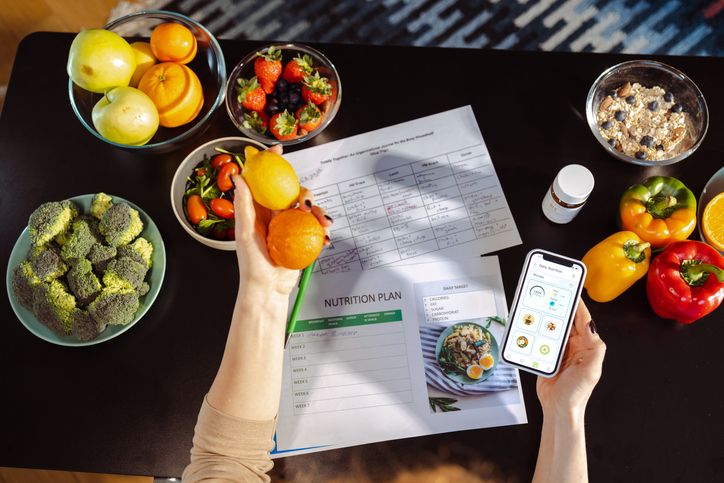
Author: Natalie Ng|Updated: 30 April 2025
If you’re trying to lose weight, the key is pretty simple—you need to eat fewer calories than your body burns. This is what’s called a calorie deficit, and it’s the foundation of healthy fat loss. When you create a calorie deficit, your body starts using stored fat for energy, and that’s when the weight starts to come off. So, how do you know how many calories to eat? A quick way to estimate it is to take your body weight and multiply it by 14 to 16. That gives you a rough idea of your maintenance calories—basically, how many calories you need to stay the same weight. From there, cutting about 20–25% is a good starting point for weight loss. Eating fewer calories doesn’t mean starving yourself. It just means making smarter choices—more lean protein, lots of fruits and veggies, whole foods, and fewer sneaky extras like oils and sauces that can add up without you noticing. Tracking your food can help you stay on track, and small changes really do add up over time. If you’ve ever wondered how many calories you should eat, or how to lose fat without losing your mind, you’re not alone. Keep reading—we’re going to break it all down and make it as straightforward as possible.

What Is a Calorie Deficit and Why It Matters

The Basics
A calorie deficit happens when you eat fewer calories than your body uses in a day. This is the foundation of weight loss. When your body doesn’t get enough energy from food, it starts using stored body fat to keep things running. Over time, this leads to fat loss.
Why Your Body Needs Calories
Your body burns calories every day—even when you’re resting. This is called your basal metabolic rate (BMR). On top of that, things like walking, exercising, and even digesting food all add to your daily calorie needs. If you eat more calories than you burn, you gain weight. If you eat fewer, you lose fat.
What a Calorie Deficit Looks Like
You don’t need to follow a super strict or low calorie diet. Creating a calorie deficit doesn’t mean skipping meals or cutting out all your favorite foods. It’s more about balance—eating fewer calories while still getting enough nutrients to support your muscle mass, energy, and overall health.
Choosing minimally processed foods, lean protein, fruits and vegetables, and watching out for hidden food calories—like cooking oils and sugary drinks—can help you cut calories without feeling deprived.

How to Calculate Your Maintenance Calories

What Are Maintenance Calories?
Maintenance calories are the number of calories your body needs to maintain your current weight. If you eat this amount, your weight stays the same. If you eat fewer, you lose weight. If you eat more, you gain weight. Knowing your maintenance calories helps you understand how much to eat to create a calorie deficit.
A Simple Way to Estimate
An easy way to estimate your maintenance calories is to multiply your body weight (in pounds) by 14 to 16.
• If you're less active, use the lower end (14).
• If you're more physically active, use the higher end (16).
For example, if you weigh 150 pounds and you're moderately active: 150 × 15 = 2,250 daily calories (rough estimate)
This number is a starting point. Everyone’s calorie needs are slightly different based on things like age, body fat, muscle mass, and overall activity level.
Why This Matters
Knowing your maintenance level helps you plan. To lose weight, you’ll want to eat fewer calories than this number. To gain weight or muscle, you’d eat more. This gives you control over your calorie intake and helps you avoid guessing.
Next, we’ll talk about how much to reduce your daily calories to start losing fat in a steady, healthy way.
Read More
Book Now to Experience
S6 Body Sculpting Treatment
1 Minute Self-Registration
Date should not be before minimal date

Calculating Your Ideal Calorie Deficit Range

Finding the Right Deficit for Fat Loss
Once you’ve estimated your maintenance calories, the next step is figuring out how many calories to cut. A safe and effective calorie deficit usually falls between 20–25% of your maintenance level. This range supports healthy fat loss while helping you keep muscle mass and avoid feeling overly tired or hungry.
For example, if your maintenance calories are 2,400:
• A 20% deficit would mean eating around 1,920 calories per day.
• A 25% deficit would bring it down to 1,800 calories.
This gives your body enough energy to function well while still creating a gap big enough for fat loss to happen.
Suggested Calorie Deficit Ranges by Weight
| Weight Category | Daily Deficit | Estimated Weekly Fat Loss |
|---|---|---|
| Under 150 lbs | 300–400 calories | 0.6–0.8 lbs |
| 150–200 lbs | 400–500 calories | 0.8–1.0 lbs |
| Over 200 lbs | 500–750 calories | 1.0–1.5 lbs |
| Athletes | 250–400 calories | 0.5–0.8 lbs |
These are general guidelines. Actual results vary depending on factors like body composition, physical activity, and metabolic health.
Why Smaller Deficits Are Often Better
Creating too large a deficit can work against you. Going too low—especially under 1,200 daily calories—can lead to:
• Muscle loss
• Slower metabolism
• Low energy and poor workout performance
• A higher chance of regaining weight later
A moderate deficit gives better long-term results. It helps you stay consistent, avoid burnout, and keep losing weight without harming your health.
Adjust as You Go
As you lose weight, your calorie needs drop. What worked at the start may stop working later. If weight loss slows down, adjust your calorie intake, increase physical activity, or both. Pay attention to how you feel—low energy, constant hunger, or poor recovery may mean your deficit is too large.

Common Mistakes When Creating a Calorie Deficit

Cutting Calories Too Much
One of the biggest mistakes people make is dropping their calorie intake way too low. Eating fewer than 1,200 calories a day might seem like a fast way to lose weight, but it often backfires. Your body starts slowing down to conserve energy, which means your metabolism drops. You might also lose muscle mass, feel constantly tired, and end up regaining the weight later.
Ignoring Nutrient Quality
Focusing only on the number of calories, without looking at what you're actually eating, can lead to poor results. A diet made up of mostly highly processed foods might technically fit your calorie goal, but it won’t support your energy, recovery, or health. Prioritize whole foods, lean protein, fruits and vegetables, whole grains, and healthy fats. A well balanced diet keeps you full, supports your body, and helps protect muscle.
Not Updating Your Calorie Deficit
As you lose weight, your body uses fewer calories. If you stick with the same deficit for too long, you’ll hit a plateau. That’s normal. The number of calories that created fat loss before might now be your new maintenance level. To keep making progress, reassess your calorie needs and adjust accordingly.
Forgetting Hidden Calories
A lot of people track their meals but miss small things that can really add up. Cooking oils, sauces, dressings, and sugary drinks often sneak in extra calories without you realizing it. These small amounts can erase your planned deficit. Using a food scale, checking food labels, and being aware of portion sizes helps you stay accurate.
Avoiding these common mistakes helps you stay consistent and get better results over time. Next, we’ll look at how smart nutrition choices can help you stay full, preserve muscle, and stick to your deficit without feeling like you’re constantly hungry.
Book Now to Experience
S6 Body Sculpting Treatment
1 Minute Self-Registration
Date should not be before minimal date

Nutrition Strategies to Support Your Deficit

Prioritize Protein
Eating enough protein is key when you’re in a calorie deficit. It helps preserve muscle mass, keeps you feeling full, and supports recovery if you're working out. A good goal is around 0.8 to 1 gram of protein per pound of body weight. Good sources include lean meats, fish, eggs, Greek yogurt, legumes, and plant-based proteins like tofu or tempeh.
Eat More Volume, Not More Calories
To stay satisfied while eating fewer calories, fill your meals with high-volume, low-calorie foods. Think vegetables, leafy greens, zucchini, mushrooms, and cauliflower. These foods let you eat more without going over your calorie target, and they’re packed with fiber, which helps control hunger and supports digestion.
Include Healthy Fats
Fats are more calorie-dense, but they play an important role in your body. They support hormone balance, brain function, and satiety. Add small portions of avocados, nuts, seeds, and olive oil to your meals. They help you feel full for longer without needing large amounts.
Meal Timing Matters
Spacing your meals evenly throughout the day can help with energy levels, appetite control, and cravings. Some people save more calories for the evening, since that’s when hunger tends to hit hardest. There’s no perfect eating schedule—just find what works best for your daily routine and keeps you consistent.
Stay Hydrated
Sometimes what feels like hunger is actually thirst. Drinking water between meals helps reduce unnecessary snacking and keeps your energy up. Try drinking a glass of water before reaching for a snack, especially if you’re not sure you’re actually hungry.

Maintaining Energy and Performance While in a Deficit

Focus on Nutrient-Dense Foods
When you're eating fewer calories, every bite counts. Choosing nutrient-dense foods—those that provide a lot of nutrition without a lot of calories—helps keep your body running well. Whole foods like lean protein, fresh fruit, vegetables, whole grains, and healthy fats support your energy levels and help prevent nutrient gaps that can make you feel sluggish or run-down.
Time Your Meals Around Your Day
If you’re active or work out regularly, meal timing can make a difference. Eating your largest meals before or after physical activity helps fuel your performance and supports muscle recovery. This can also help reduce cravings and prevent late-night snacking. Try to space out your meals evenly during the day to keep your blood sugar and energy levels stable.
Choose the Right Carbs
Not all carbs are the same. Skip the sugary snacks that cause quick spikes and crashes, and focus on complex carbs like oats, quinoa, brown rice, potatoes, and legumes. These give you a steady energy release and help you feel full longer. Pairing them with protein and healthy fats helps even more.
Don’t Neglect Sleep and Stress
Lack of sleep and high stress levels can mess with your hunger hormones and lower your energy, making it harder to stick to your calorie deficit. Aim for 7–9 hours of sleep each night and find ways to manage stress that work for you—whether that’s movement, social time, or quiet breaks.
A calorie deficit doesn’t mean low energy and poor performance. With the right food choices, good timing, and some attention to recovery, you can feel strong and focused while still losing fat.
Book Now to Experience
S6 Body Sculpting Treatment
1 Minute Self-Registration
Date should not be before minimal date

Tracking Progress and Adjusting Your Deficit

Watch More Than Just the Scale
The scale can help you monitor trends, but it shouldn’t be your only progress check. Weight naturally fluctuates from day to day because of water retention, hormones, and digestion. This makes short-term changes hard to read. To get a clearer picture, use a mix of tracking tools:
• How your clothes fit
• Progress photos every few weeks
• Body measurements (like waist or hips)
• Energy levels and workout performance
• Your consistency with calorie intake
Looking at these together helps you understand what’s really changing—especially when the number on the scale stays still.
Make Small, Gradual Adjustments
If fat loss slows down or stalls, don’t panic. A plateau is normal as your body adjusts. Start by reviewing your food tracking—hidden calories from things like sauces or snacks may be sneaking in. If you're on track and still not seeing results for two or more weeks, try:
• Reducing daily calories slightly (100–200 calories)
• Increasing physical activity, even just by walking more
• Recalculating your calorie needs based on your current weight
Avoid drastic cuts. Keeping things steady and making small changes helps maintain muscle and energy while continuing fat loss.
Pay Attention to How You Feel
A proper calorie deficit shouldn’t leave you feeling exhausted, hungry all the time, or burned out. If you feel that way, it’s worth adjusting your plan. Fat loss works best when it fits into your routine without pushing your body too hard.

Boosting Your Calorie Deficit with S6 Body Sculpting Treatment
Supporting Fat Loss Beyond Diet
Maintaining a calorie deficit is key to losing body fat—but it’s not always easy. Some areas, like the belly, arms, or thighs, tend to hold onto fat even when you’re eating fewer calories and staying active. That’s where the S6 Body Sculpting Treatment can help. It’s a non-invasive body contouring method designed to speed up fat reduction in stubborn areas, working alongside your calorie intake goals for better, faster results.
How the Treatment Works
The S6 Body Sculpting Treatment combines bio-laser technology with vacuum suction. Here’s what happens:
• The bio-laser penetrates the skin and breaks down fat cells into fatty acids.
• Then, vacuum suction promotes lymphatic drainage, helping your body flush out the released fatty acids.
• The process directly targets subcutaneous fat in areas like the waist, belly, arms, thighs, calves, knees, and buttocks.
This treatment supports fat loss without the need for surgery, needles, or long recovery times—making it a solid option for people who are already working on weight management through a low calorie diet or high protein diet but want more focused results.
Why It Works Well with a Calorie Deficit
When you're eating fewer calories and trying to lose weight, your body is already in fat-burning mode. The S6 treatment helps enhance that process by physically breaking down fat cells and speeding up how your body removes them. This means you can potentially see changes in your shape faster, especially in areas where fat is harder to lose through diet alone.
Pairing a healthy diet, physical activity, and a calorie deficit with targeted treatments like S6 gives your fat loss efforts a boost—without needing extreme changes or extra strain on your routine.
Key Advantages
• Non-invasive and painless
• No recovery time
• Targets hard-to-lose fat in specific areas
• Complements your existing weight loss strategy
• No impact on muscle mass or energy levels
If you’re already working on your weight loss goals through smart food intake and activity, the S6 Body Sculpting Treatment can give you the extra push you need—especially for those areas that don't seem to respond.
Book your consultation today to see how the S6 Body Sculpting Treatment can support your fat loss and help shape a leaner, more defined body.
New Beauty's S6 Body Sculpting TreatmentBook Now to Experience
S6 Body Sculpting Treatment
1 Minute Self-Registration
Date should not be before minimal date
FAQ
How Long Can I Safely Maintain a Calorie Deficit?
You can safely maintain a calorie deficit for 12-16 weeks before needing a break. After that, your body needs time to reset hormones and metabolism. Take a 1-2 week break at maintenance calories, then resume if needed. Don't exceed a 500-calorie daily deficit to protect muscle mass and keep your energy levels stable. Listen to your body's signals throughout the process.
Will a Calorie Deficit Affect My Medication's Effectiveness?
A calorie deficit can impact how your body processes medications, so you'll need to be extra careful. Some medications require specific timing with food or certain nutrient levels to work properly. Don't make changes to your diet without consulting your healthcare provider first. They'll help guarantee your calorie reduction won't interfere with your medication's effectiveness and might need to adjust your dosages accordingly.
Does the Timing of Meals Impact the Success of a Deficit?
While meal timing isn't the primary factor in your success, it can support your deficit goals. You'll get the best results by spacing your meals to manage hunger and energy levels throughout the day. Don't feel trapped by rigid eating schedules - your body can burn fat effectively regardless of when you eat. Focus on your total daily calories rather than obsessing over specific mealtimes.
Can I Build Muscle While Maintaining a Calorie Deficit?
Building muscle in a deficit is challenging but possible if you're new to training or returning after a break. You'll need to keep your protein high (around 1g per pound of body weight), maintain intense resistance training, and guarantee your deficit isn't too aggressive - aim for a modest 20% reduction in calories.
Should I Adjust My Deficit During Illness or Injury?
During illness or injury, you'll want to reduce or eliminate your calorie deficit. Your body needs adequate energy and nutrients to heal properly. Return to maintenance calories or even a slight surplus to support recovery. Listen to your body and don't push the deficit until you're fully recovered. Continuing a deficit while sick or injured can slow healing and compromise your immune system's ability to fight back.
Recommended Articles
COPYRIGHT© NEW BEAUTY MANAGEMENT LIMITED 2025. ALL RIGHT RESERVED.




